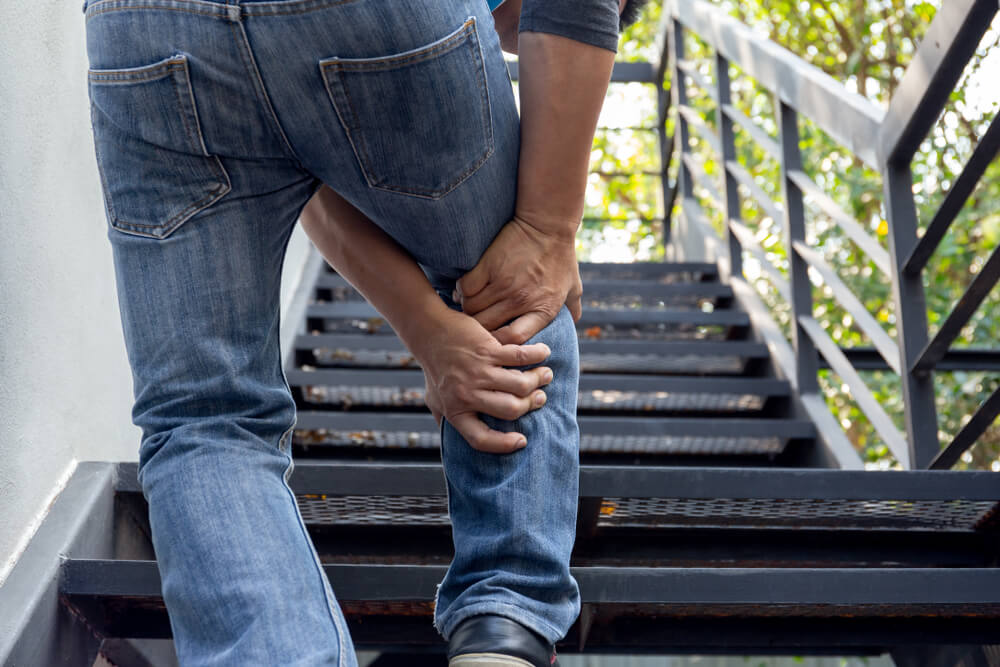The knee is a complex joint that connects the femur (thighbone) to the tibia (shinbone). It is also made up of bones, ligaments, cartilage, tendons and muscles that work together to allow you to move and bear weight. Pain in your knee can cause a significant disruption to your daily life. This can include pain when you are going down stairs. This pain can be caused by a variety of factors. Most conditions or injuries can be treated to improve your quality of life.
Common causes of knee pain when going down stairs
If your knees are causing you pain as you go down stairs, it is important to uncover the underlying issue of your pain so you can seek treatment. Common culprits behind knee pain when descending stairs can include:
- Meniscus tears — The meniscus is a cartilage cushion in the knee joint that absorbs shock from movement. It can become torn and can lead to pain in the knee during movements.
- Osteoarthritis — Osteoarthritis is a degenerative condition in the joints. As the cartilage wears down in a joint, it can cause bones to rub together, causing pain in the joint. Knee osteoarthritis is the most common form of osteoarthritis, affecting 365 million people.
- Patellofemoral pain syndrome — Patellofemoral pain syndrome is also known as runner’s knee. This condition is caused by irritation of the cartilage under the patella (kneecap). It can become exacerbated by activities involving bending the knee, like going down the stairs. This irritation can lead to knee pain.
- IT band syndrome — The iliotibial (IT) band is a tendon that runs along the outside of your thigh to your knee. It can become tight or inflamed. This can cause pain, especially when going down stairs.
Ways to reduce knee pain when going down stairs
Knee pain when going down the stairs doesn’t have to keep you in its grip. There are a variety of strategies you can adopt to help you deal with or alleviate the pain in your knee. Ways to reduce pain can include:
- Rest and ice — Resting your knee can give it time to heal. Icing your knee can help calm any inflammation you may be dealing with. It can also help provide you with pain relief.
- Medications — Over-the-counter medications can help alleviate pain and reduce inflammation from injuries or conditions causing your knee pain.
- Bracing — If you are dealing with an instability issue, a knee brace can help provide you with stability and can also help reduce pain.
- Injections — Depending on the underlying issue causing your pain, your health care professional may recommend a corticosteroid injection to help provide pain relief and inflammation reduction.
- Physical therapy — Physical therapy can be a beneficial treatment approach. Depending on the underlying condition or injury, a physical therapy treatment plan can be designed around your specific needs.
Physical therapy for knee pain
Going up and down the stairs should not cause you pain. If you are experiencing pain when going down stairs, physical therapy is an effective treatment option. There are a number of modalities that can be beneficial for reducing inflammation, alleviating pain, or addressing other issues causing your knee pain. Modalities of physical therapy can include:
- Manual therapy — Manual therapy includes hands-on techniques like soft tissue mobilization and joint mobilization. These techniques are used by physical therapists to help improve joint mobility, alleviate pain and promote healing.
- Electrical stimulation — Electrical stimulation uses a device like the TENS unit to send low-level electrical currents through soft tissue to help stimulate nerves and muscles. It can help reduce pain, reduce muscle spasms and boost circulation.
- Instrument-assisted soft tissue mobilization (IASTM) — IASTM is a technique where a physical therapist uses specially designed instruments to gently manipulate the soft tissue around the knee. This is done to help address any pain or discomfort you are experiencing. This technique can help break down scar tissue, improve circulation, and promote tissue healing. It can also help improve your range of motion.
- Therapeutic exercises — Specific exercises intended to address issues causing your knee pain can help you to strengthen the muscles around your knee joint. They can also help improve your stability and flexibility. Your physical therapist will choose exercises to meet your specific needs and abilities to help reduce your knee pain when going down stairs.
- Myofascial release — Myofascial release targets the connective tissue (called fascia) that covers muscles and organs to help release tension. A physical therapist will use pressure and gentle stretching for myofascial release to help alleviate your pain. Myofascial release can also help to improve flexibility and improve circulation.
Physical therapy can provide you with a number of treatments that can help alleviate your knee pain. These techniques can help address the underlying cause of the pain and the symptoms you are experiencing. A physical therapist will design a custom treatment plan around your particular needs and concerns. This treatment plan can include a variety of modalities best suited to you and can be adjusted through your time in physical therapy.
Whatcom PT can help you to alleviate your knee pain when going down stairs
Whatcom Physical Therapy can help you find pain relief from the knee pain that is causing you discomfort when using the stairs. Our team of expert physical therapists are committed to helping you to discover the underlying issues causing the pain and helping guide you to an improved quality of life.
Contact our team today for more information or to schedule an initial appointment.

